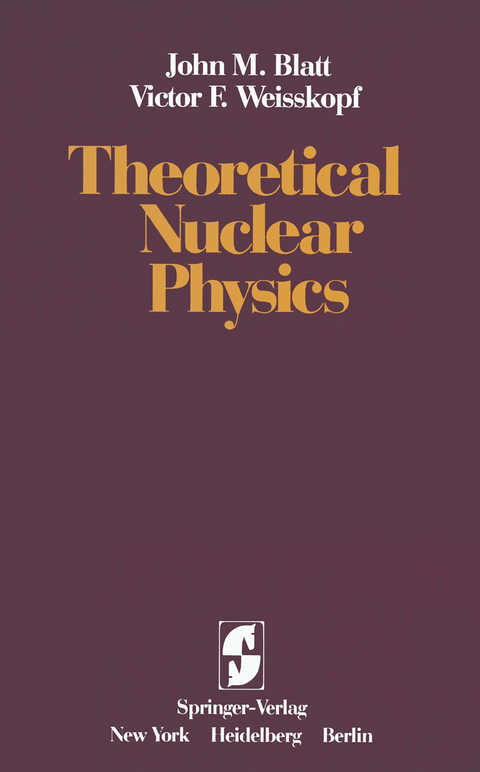
Theoretical Nuclear Physics
Springer-Verlag New York Inc.
978-1-4612-9961-5 (ISBN)
The last twenty years have witnessed an enormous development of nuclear physics. A large number of data have accumulated and many experimental facts are known. As the experimental techniques have achieved greater and greater perfection, the theoretical analysis and interpretation of these data have become correspondingly more accurate and detailed. The development of nuclear physics has depended on the development of physics as a whole. While there were interesting speculations about nuclear constitution as early as 1922, it was impossible to make any quantitative theory of even the simplest nucleus until the discovery of quantum mechanics on the one hand, and the development of experimental methods sufficiently sensitive to detect the presence of a neutral particle (the neutron) on the other hand. The further development of our understanding of the nucleus has depended, and still depends, on the development of ever more powerful experimental techniques for measuring nuclear properties and more powerful theoretical techniques for correlating these properties. Practically every "simple," "reasonable," and "plausible" assumption made in theoretical nuclear physics has turned out to be in need of refinement; and the numerous attempts to derive nuclear forces and the properties of nuclei from a more" fundamental" approach than the analysis of the data have proved unsuccessful so far. Nuclear physics is by no means a finished edifice.
I. General Properties of the Nucleus.- 1. Introduction.- 2. Quantum States, Binding Energy, Binding Fraction.- 3. Stable and Unstable Nuclei, Fission, Alpha-Decay, Beta-Decay.- 4. Size of the Nuclei.- 5. The Coulomb Barrier.- 6. Angular Momentum, Spin.- 7. Electric and Magnetic Moments.- 8. Statistics.- Symbols.- II. TWO-BODY PROBLEMS AT LOW ENERGIES.- 1. Introduction.- 2. The Ground State of the Deuteron; Simplified Discussion (Central Forces Assumed).- 3. Neutron-Proton Scattering.- 4. Proton-Proton Scattering.- 5. The Tensor Force.- Symbols.- III. Nuclear Forces.- 1. Introduction.- 2. Stability of a nucleus against Collapse. The Impossibility of Attractive Forces between All Pairs.- 3. Exchange Forces.- 4. The Saturation Conditions.- 5. The Isotopic Spin Formalism.- Symbols.- IV. Two-Body Problems at High Energies.- 1. Introduction.- 2. Neutron-Proton Scattering at Energies between 10 and 30 Mev.- 3. Neutron-Proton Scattering at Energies Larger than 30 Mev.- 4. Proton-Proton Scattering.- Symbols.- V. Three- and Four-Body Problems.- 1. Introduction.- 2. The Ground State of the Triton; Central Forces.- 3. The Ground State of the Alpha-Particle; Central Forces.- 4. H3 and He3: The Equality of Neutron-Neutron and Proton-Proton Forces.- 5. The Ground State of the Triton; Tensor Forces.- Symbols.- VI. Nuclear Spectroscopy: I. General Theory.- 1. The Systematics of Stable Nucle.- 2. The Semi-Empirical Mass Formula of Weizsäcker.- 3. Detailed Study of the Symmetry Effect.- 4. The Symmetry Energy and the Systematics of Stable Nuclei.- 5. Nuclear Magnetic Moments in Light Elements.- 6. The Spectroscopic Classification of Nuclear Energy Levels.- Symbols.- VII. Nuclear Spectroscopy: II. Special Models.- 1. Introduction.- 2. The Uniform Model of Wigner.- 3. TheIndependent-Particle Model.- 4. The Alpha-Particle Model of the Nucleus.- 5. The Liquid Drop Model.- Symbols.- VIII. Nuclear Reactions: General Theory.- 1. Introduction.- 2. Cross Sections.- 3. The Compound Nucleus, Continuum Theory.- 4. Determination of Cross Sections, Continuum Theory.- 5. Transmission of Potential Barriers.- 6. The Decay of the Compound Nucleus.- 7. Resonance Theory; Qualitative Treatment.- 8. Resonance Theory; Determination of Cross Sections.- 9. Resonance Theory; Decaying States of the Compound Nucleus.- 10. Spin And Orbital Angular Momentum.- Symbols.- IX. Nuclear Reactions; Application of the Theory to Experiments.- 1. Introduction.- 2. Neutron-Induced Reactions.- 3. Proton- and Alpha-Particle-Induced Reactions.- 4. Neutron-, Proton-, and Alpha-Particle-Induced Reactions at Ultrahigh Energies.- 5. Reactions with Light Nuclei.- 6. Deuteron-Induced Reactions.- Symbols.- X. Formal Theory of Nuclear Reactions.- 1. The Scattering Matr.- 2. Conservation and Reciprocity Theorems for Nuclear Reactions.- 3. The Angular Distribution of Reaction Products.- 4. The Wigner Many-Level Formula.- Symbols.- XI. Spontaneous Decay Of Nuclei.- 1. Energetic Considerations.- 2. General Theory of Alpha-Decay.- 3. Discussion of Experimental Data.- Symbols.- XII. Interaction of Nuclei with Electromagnetic Radiation.- 1. Introduction.- 2. Multipole Radiation and Selection Rules.- 3. The Probability of Multiple Emission and Absorption.- 4. Radiative Transitions in the Two-Body Problem.- 5. Internal Conversion.- 6. Transitions Between Low-Lying States Of Nucle.- 7. Transitions Involving Highly Excited States.- XIII. Beta-Decay.- 1. Introduction.- 2. The Neutrino Hypothesis and the Shape of the Beta-Spectrum Selection Rules for “Allowed” Transitions.- 3. Orbital ElectronCapture.- 4. The Half-Lives of Beta-Emitters and Evidence Concerning the Selection Rules in Allowed Transitions.- 5. Detailed Theory Of Beta-Decay; Transitions Of Order.- 6. Determination of Matrix Elements; Favored and Unfavored Transitions.- 7. Beta-Transitions of Higher Order.- Symbols.- XIV. Nuclear Shell Structure.- 1. Evidence for the Existence Of “Magic Numbers”.- 2. The Nuclear Shell Model.- 3. General Considerations.- Symbols.- Appendix A. Angular Momentum Operators and Eigenfunctions.- 1. Rotations and Angular Momenta.- 2. Spherical Harmonics.- 3. Expansion of a Plane Wave into Spherical Waves.- 4. Intrinsic Spin.- 5. Vector Addition of Angular Momenta.- Symbols.- Appendix B. Multipole radiation.- 1. Vector Spherical Harmonics.- 2. Electric and Magnetic Multipole Expansion in Free Space.- 3. Energy and Angular Momentum of the Multipole Radiation.- 4. The Sources of Multipole Radiation; Multipole Moments.- 5. Expansion of a Plane Wave into Multipole Fields.- 6. The Absorption Probability of a Light Quantum.- Symbols.- References.
| Zusatzinfo | XIV, 864 p. |
|---|---|
| Verlagsort | New York, NY |
| Sprache | englisch |
| Maße | 152 x 229 mm |
| Themenwelt | Naturwissenschaften ► Physik / Astronomie ► Atom- / Kern- / Molekularphysik |
| Naturwissenschaften ► Physik / Astronomie ► Plasmaphysik | |
| Schlagworte | Kernphysik • Nuclear • Physics |
| ISBN-10 | 1-4612-9961-6 / 1461299616 |
| ISBN-13 | 978-1-4612-9961-5 / 9781461299615 |
| Zustand | Neuware |
| Haben Sie eine Frage zum Produkt? |
aus dem Bereich


